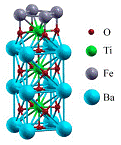Department of Physics and Astronomy: Publications and Other Research

Evgeny Tsymbal Publications
ORCID IDs
Tsymbal http://orcid.org/0000-0002-6728-5528
Document Type
Article
Date of this Version
2-2012
Citation
MRS Bulletin (2012) 37: 138-143
Abstract
The phenomenon of electron tunneling has been known since the advent of quantum mechanics, but continues to enrich our understanding of many fields of physics, as well as creating subfields on its own. Spin-dependent tunneling in magnetic tunnel junctions has aroused considerable interest and development. In parallel with this endeavor, recent advances in thin-film ferroelectrics have demonstrated the possibility of achieving stable and switchable ferroelectric polarization in nanometer-thick films. This discovery opened the possibility of using thin-film ferroelectrics as barriers in magnetic tunnel junctions, thus merging the fields of magnetism, ferroelectricity, and spin-polarized transport into an exciting and promising area of novel research. Nowadays, this research has become an important constituent of a broader effort in multiferroic materials and heterostructures that involves rich fundamental science and offers a potential for applications in novel multifunctional devices. The purpose of this article is to review recent developments in ferroelectric and multiferroic tunnel junctions. Starting from the concept of electron tunneling, we first discuss the key properties of magnetic tunnel junctions and then assess key functional characteristics of ferroelectric and multiferroic tunnel junctions. We discuss the recent demonstrations of giant resistive switching observed in ferroelectric tunnel junctions and the new concept of electrically controlling the spin polarization in magnetic tunnel junctions with a ferroelectric tunnel barrier.


Comments
Copyright © 2012, Materials Research Society. Used by permission